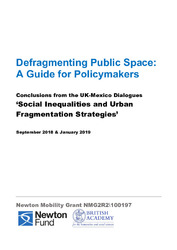| dc.description.abstract | While social inequalities remain key features of numerous cities globally, many still manage to provide spaces for collective social life, including public streets, market spaces and parks.
Yet many countries today, with growing and significant socio-economic disparities and a rising fear of crime and violence, now see a range of strategies by their wealthiest citizens to
avoid public spaces. This avoidance has generated a more fragmented engagement with the city by particular social groups. These processes, including the avoidance of public spaces and normalisation of gated communities, are reshaping cities leaving fewer shared spaces for collective life as public spaces are privatised. This report comes from a dialogue between
researchers with interests in the risks and challenges for the public life of cities and these new and growing patterns of segregation and social avoidance. The collaboration between scholars and institutions seeks to understand the increasingly defensive quality of many urban centres and to identify forms of policy, practice and urban interventions capable of ensuring public safety and participation by all citizens.
The purpose of this report is to engage researchers and practitioners in the discussion about the risks and challenges associated with urban fragmentation strategies and the means by which safer, more inclusive and liveable public spaces might be achieved. The document offers a series of reflections collated from scholars that participated in symposia organised in Mexico and the UK. The discussion produced statements of good practice to promote both open and secure urban public spaces centred on the areas of urban policy and professional practice. | spa |

